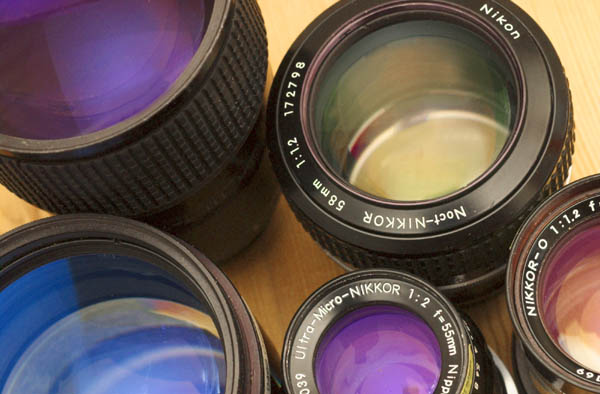Need for Speed
by
Bjørn Rørslett |
| First | 2 | 3 | Last | Page
|
| |
|
I possess a number of
candidate lenses for shooting soft, shallow-focus images.
Although the intuitive approach would be selecting long focal
lengths, the largest apertures are more easily attained with
lenses in the 50-85 mm range. An added advantage is that these
shorter lenses lend themselves for hand-held photography. This in
turn leads to more easy-going and enjoyable shooting for the
photographer and eventually might unleash a creative power all of
its own.

|
Very Large Apertures
|
©
Bjørn Rørslett/NN |
A broad selection of the large
aperture lenses applied in my high-speed, close-up
photography. (More have been added after this picture
was taken, amongst them the famous Repro-Nikkor 85 mm f/1
and a Rodenstock TV-Heligon 42 mm f/0.75. A Kowa 55 mm
f/0.8 and a MATI 86 mm f/1.2 are the newest additions to
my collection, plus several Rodenstcoks, such as 64 mm
f/1.25, 95 mm f/1.4 and 100 mm f/1.5 lenses. All of these
are carried in a metal case which now doubles as
weightlifting dumbells ).
Depicted from left to right:
Rodenstock XR-Heligon 75 mm f/1.1 and Noct-Nikkor 58 mm
f/1.2, and in front row, Rodenstock TV-Heligon 50 mm
f/0.75, Ultra-Micro-Nikkor 55 mm f/2, and Nikkor-O 55 mm
f/1.2 CRT lens. The Noct-Nikkor lens needs an extension
ring to bring it into the close-up range, and a matrix
chip-equipped E2 ring is just the appropriate means to
this end. The XR-Heligon has been updated with a matrix
chip, too, and the TV-Heligon will be next on the upgrade
path.
|
The selected lenses all have
different maximum effective aperture and image magnification. I
have compiled the relevant data for these lenses in the table
below. Please note that for such close-up shooting conditions,
there can be a great discrepancy between nominal and effective
aperture. Remember f-numbers are specified for infinity focus.
Moreover, due to the various optical designs, even greater
variability is introduced. Thus, when the pupil magnification (p)
is factored into the equation, some of the seeming blindingly
fast lenses fade into the not-so-extreme category. However, any
of these lenses still are much faster than a
Micro-Nikkor set to an equal magnification.
| Lens |
Image
magnification* m
|
Pupil magnification**
p
|
Effective
aperture***
Neff |
Field
Curvature
|
Ultra-Micro-Nikkor
55 mm f/2 |
0.39 |
~
1 |
2.8 |
Negligible
(+) |
Rodenstock
XR-Heligon
75 mm f/1.1 |
0.5 |
~
0.4 |
2.5
|
Intermediate
(+) |
Noct-Nikkor
58 mm f/1.2
plus E2 ring |
0.3
- 0.4 |
~
0.8 |
1.6
- 1.8 |
Intermediate
(+) |
Nikkor-O
55 mm
f/1.2 CRT lens |
0.26 |
~
0.9 |
1.6 |
Strong
(-) |
Rodenstock
TV-Heligon
50 mm f/0.75 |
0.62 |
~
0.4 |
2.0 |
Strong
(+) |
Repro-Nikkor
85 mm f/1 |
1.0 |
1.0 |
2.0 |
Zero |
|
|
* m
= ratio of recorded object size to actual size
** p
= (exit pupil diameter)/(entrance pupil diameter)
*** Neff
= N (1 + m/p)
The advertised large-aperture
value of fast lenses is valid only for infinity focus and when
they cover their designated image format. Step way outside these
parameters and the effective aperture may be significantly
reduced (as shown in the Table above).
Also note that many of these
lenses lack a focusing mechanism so they act as fixed-focus
lenses only. Since none of them are general-purpose lenses, I
find this draw-back of less importance in practice. I simply have
to think and plan ahead for my photographic assigments which in
itself is a bonus.
